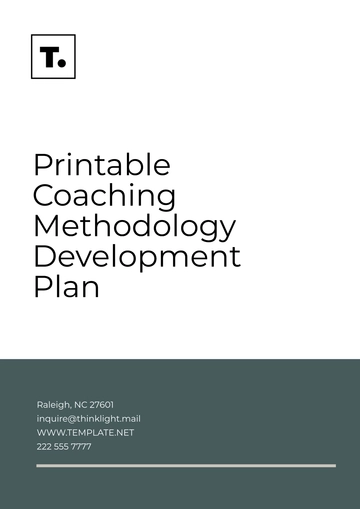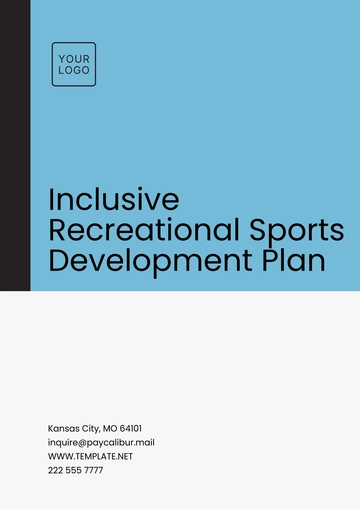Free Aesthetic Charity Sports Event Development Plan

Prepared by: [Your Name]
Date: June 12, 2050
1. Introduction
This development plan outlines the key objectives, strategies, and operational steps necessary for organizing a successful charity sports event. The event will focus on fostering community engagement, raising funds for charitable causes, and promoting physical fitness and well-being. The plan includes comprehensive strategies for planning, marketing, operations, financial management, and post-event evaluation to ensure success.
2. Objectives
The primary objectives of the charity sports event are:
Raising Funds: Support designated charities by raising substantial funds through participant registration, donations, and sponsorships.
Community Engagement: Encourage local community participation and interaction.
Promoting Health and Fitness: Advocate for physical well-being and inspire participants to adopt healthier lifestyles.
Providing Entertainment: Offer a fun, engaging, and family-friendly experience that encourages repeat attendance.
3. Event Planning and Management
3.1 Event Conceptualization
The conceptualization stage establishes the nature of sports events like a 5K run, charity basketball match, or cycling race, outlines specific event objectives, and determines the intended audience, laying a groundwork for comprehensive planning in all aspects. It should also account for the event's theme, distinct advantages, and possible collaborations with pertinent organizations.
3.2 Budget Planning
A detailed budget ensures the feasibility of the event and provides a framework for managing resources effectively. The budget should cover all essential categories such as:
Category | Estimated Cost |
|---|---|
Venue Rental | $5,000 |
Marketing and Promotion | $2,500 |
Equipment Rental | $3,000 |
Personnel and Volunteers | $1,500 |
Miscellaneous (permits, insurance, etc.) | $1,000 |
Total | $13,000 |
3.3 Timeline Development
The timeline will help ensure that all tasks are completed on time. Key milestones include:
Event Planning: 6 months prior
Marketing and Promotion: 4 months prior
Registration Opens: 3 months prior
Finalize Logistics: 2 months prior
Event Day Preparation: 1 month prior
Event Execution: Event Day
4. Marketing and Promotion
4.1 Target Audience and Outreach
Identifying and understanding the target audience is crucial for effective outreach. Focus on local communities, families, sports enthusiasts, and potential sponsors. Use demographics and interests to tailor messages and attract diverse groups of participants and donors.
4.2 Promotional Strategies
Promotion should utilize a multi-channel approach to maximize visibility and engagement:
Social Media Campaigns: Engage with audiences on platforms like Facebook, Instagram, and Twitter.
Press Releases and Media Coverage: Secure media partnerships to increase exposure.
Partnerships with Local Businesses and Influencers: Leverage local networks for promotion and support.
Email Newsletters: Create engaging newsletters with event updates, registration details, and donation information.
5. Operations and Logistics
5.1 Venue Selection and Setup
Choosing the right venue is essential for participant comfort and overall event success. Factors to consider include:
Location: Easy accessibility for participants and attendees.
Size and Layout: Adequate space for different sports activities and audience accommodation.
Safety: Availability of first-aid services, crowd control measures, and emergency exits.
Parking and Accessibility: Ensure enough parking space and accommodations for people with disabilities.
5.2 Equipment and Resource Management
Proper equipment and resources are vital for the success of the event:
Sports Gear: Obtain the required sports gear, such as balls, bibs, bikes, and similar items.
Hydration Stations: Provide water and refreshments throughout the event.
First Aid and Safety Kits: Ensure on-site medical support and supplies.
Rental Needs: Arrange for any additional items such as tents, stages, or sound systems.
5.3 Personnel and Volunteer Coordination
Recruiting and managing volunteers is essential for the smooth operation of the event. Tasks for volunteers should be clearly outlined, and they should be trained on their responsibilities, including:
Event Registration
Crowd control
First aid
Emergency procedures
A volunteer coordinator should oversee their deployment and ensure their engagement throughout the event.
6. Financial Management
6.1 Funding and Sponsorship
Sponsorship and partnerships with local businesses or corporations play a key role in covering event expenses. Create attractive sponsorship packages that include:
Branding Opportunities: Sponsor logos on event banners, T-shirts, and marketing materials.
Exclusive Access: VIP access or booths for sponsors.
Event Recognition: Public acknowledgment during the event and in post-event materials.
6.2 Budget Monitoring and Reporting
Continuous budget monitoring is necessary to ensure financial control. Track expenses and income closely throughout the planning phase and during the event. After the event, prepare a financial report detailing:
Total funds raised for charity
Event expenses
Sponsorship contributions
Surplus funds allocation
7. Post-Event Evaluation and Reporting
7.1 Event Success Metrics
The success of the event should be evaluated using both quantitative and qualitative metrics:
Participation Numbers: Compare the number of participants to goals set during the planning phase.
Funds Raised: Track the funds generated for the chosen charities.
Attendee Feedback: Collect feedback through surveys to assess attendee satisfaction.
Volunteer Satisfaction: Gauge the experience and feedback from volunteers.
7.2 Reporting Outcomes
Following the event, prepare a comprehensive post-event report that includes:
An analysis of participation, funds raised, and event execution.
Challenges encountered and how they were overcome.
Recommendations for future events.
The impact on the chosen charities, including how the funds will be used.
8. Sustainability Considerations
Incorporating sustainable practices into the event can have long-term benefits. These include:
Minimizing Waste: Use recyclable materials and avoid single-use plastics.
Energy Efficiency: Opt for energy-efficient lighting and equipment.
Green Initiatives: Encourage attendees to carpool or use public transportation.
9. Conclusion
This development plan provides a structured approach to organizing a successful charity sports event. By focusing on clear objectives, detailed planning, effective marketing, and thorough evaluation, the event will not only raise funds for charitable causes but also engage the community in promoting physical fitness and well-being. The comprehensive nature of this plan ensures the event is impactful, enjoyable, and sustainable.
- 100% Customizable, free editor
- Access 1 Million+ Templates, photo’s & graphics
- Download or share as a template
- Click and replace photos, graphics, text, backgrounds
- Resize, crop, AI write & more
- Access advanced editor
The Aesthetic Charity Sports Event Development Plan Template from Template.net is a fully editable and customizable solution for organizing your charity event. With easy-to-use features, this template is editable in our Ai Editor Tool, allowing you to personalize it to your unique needs. Simplify your event planning with this professional, adaptable template today!





























